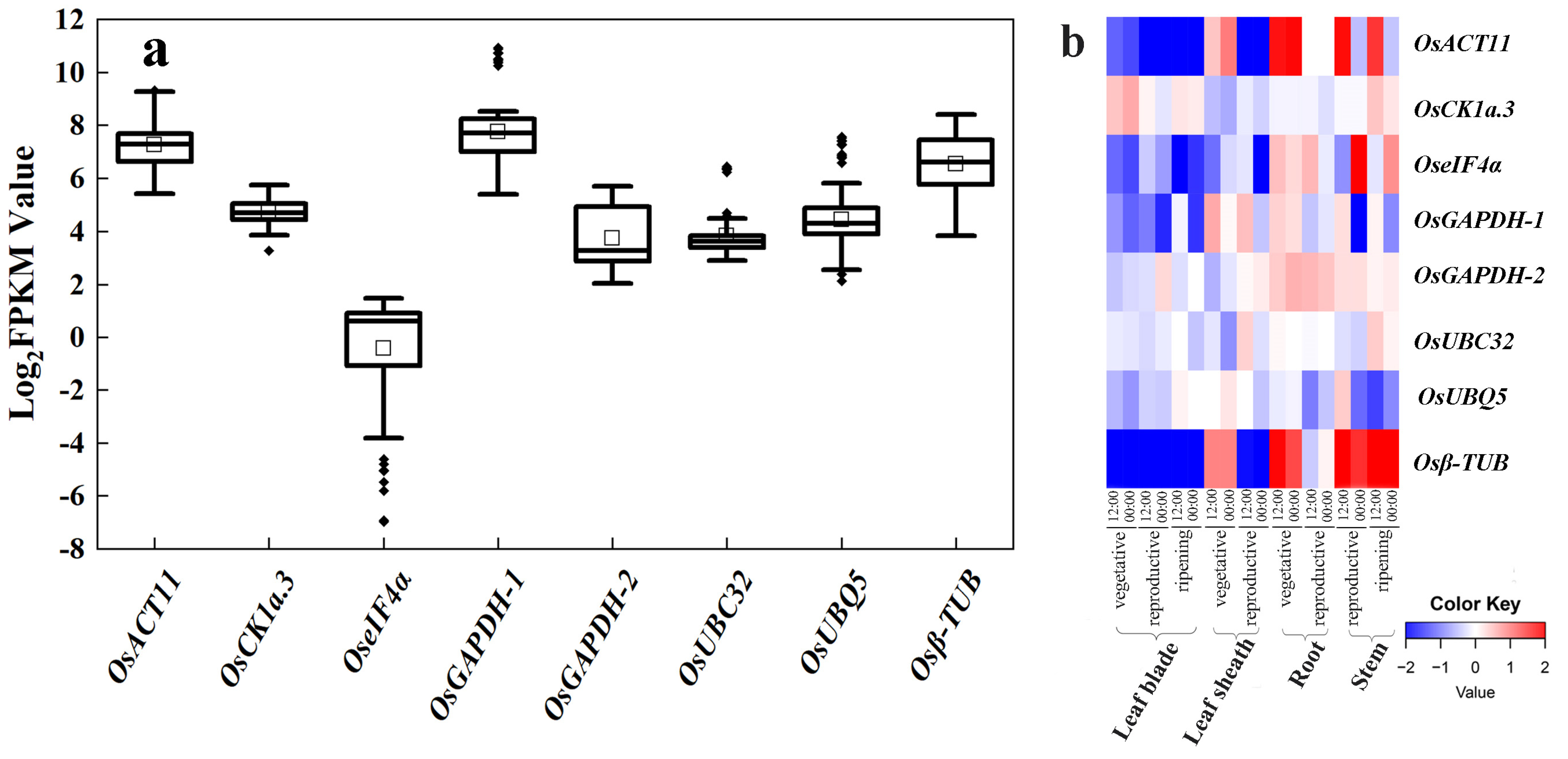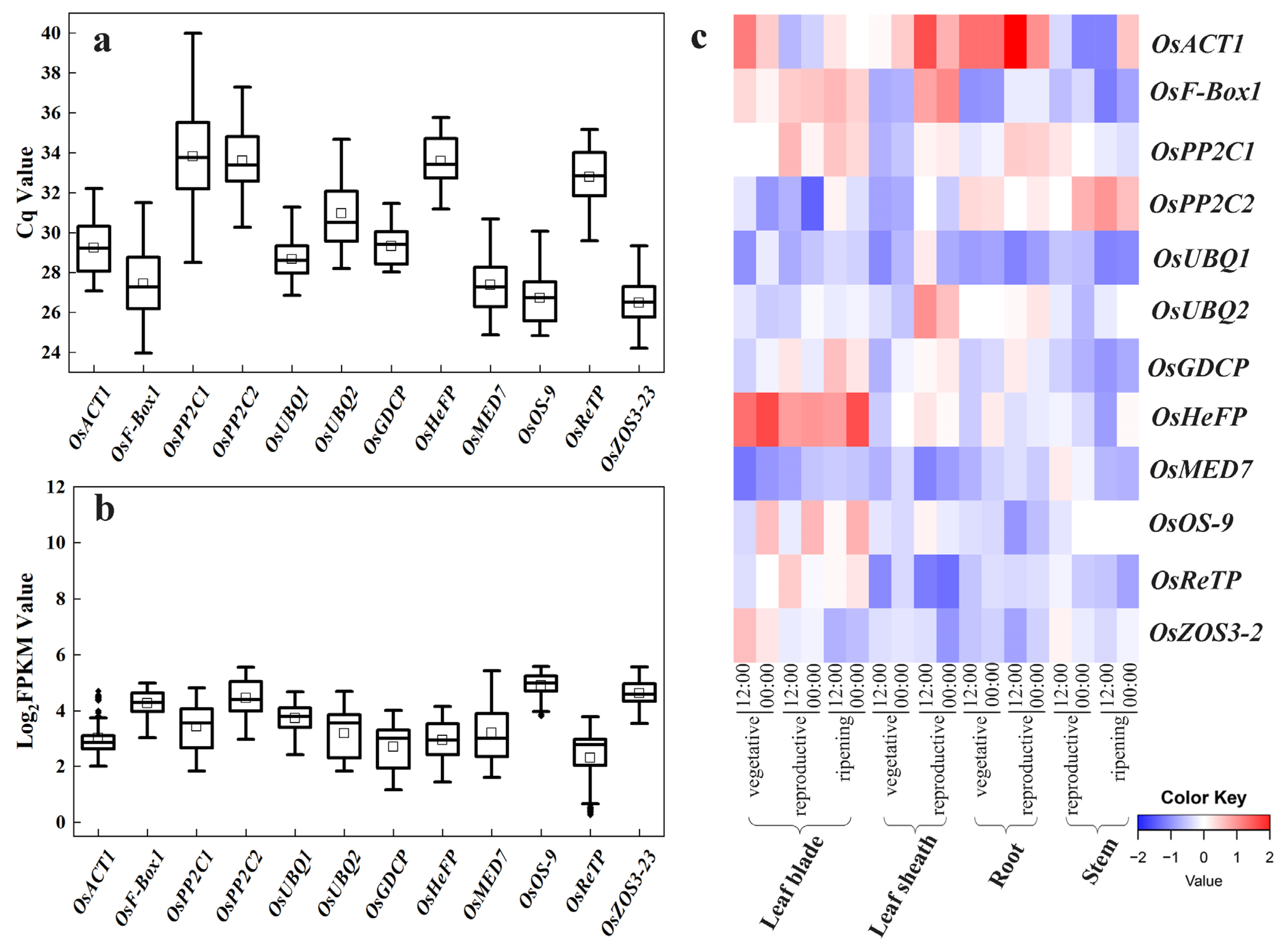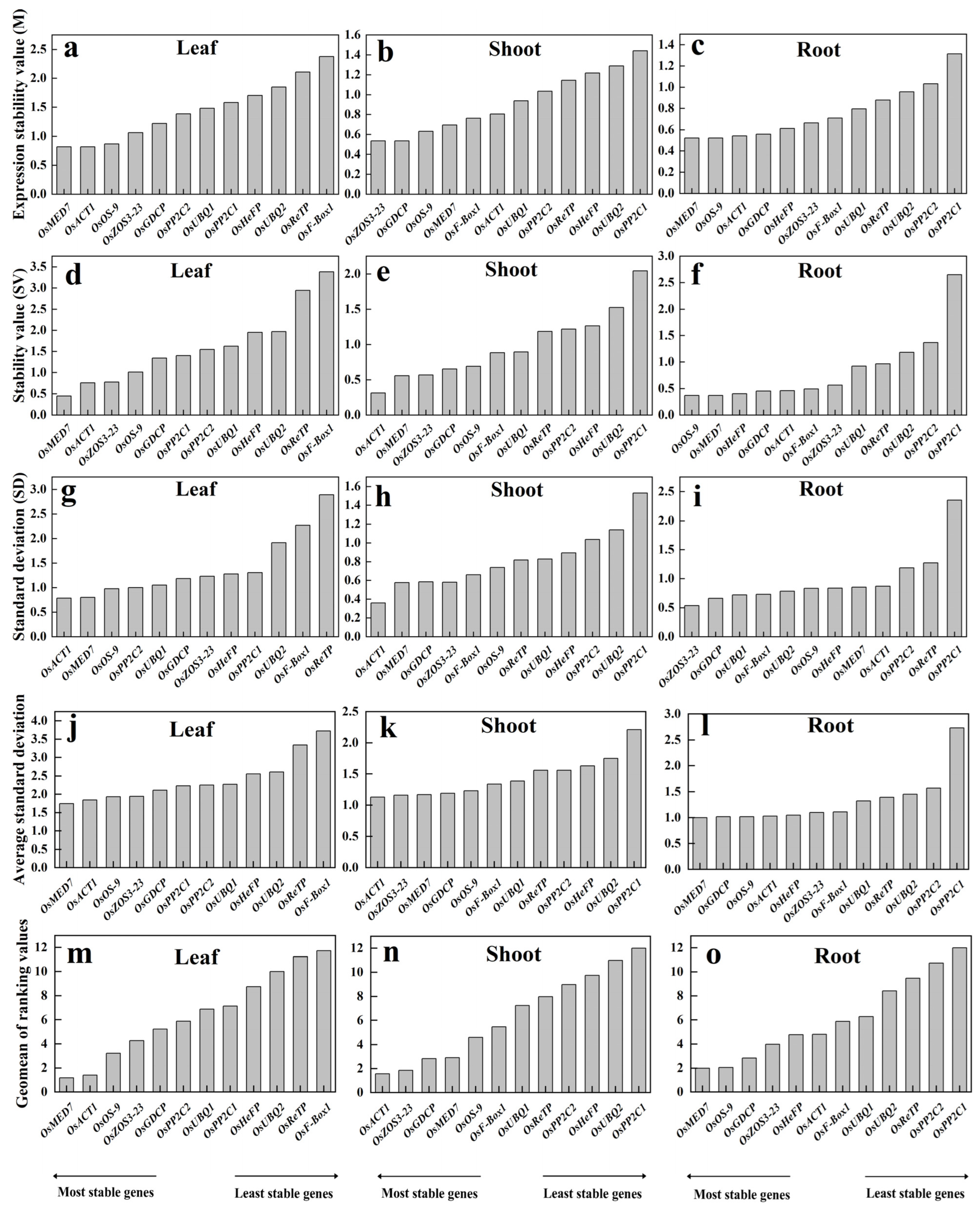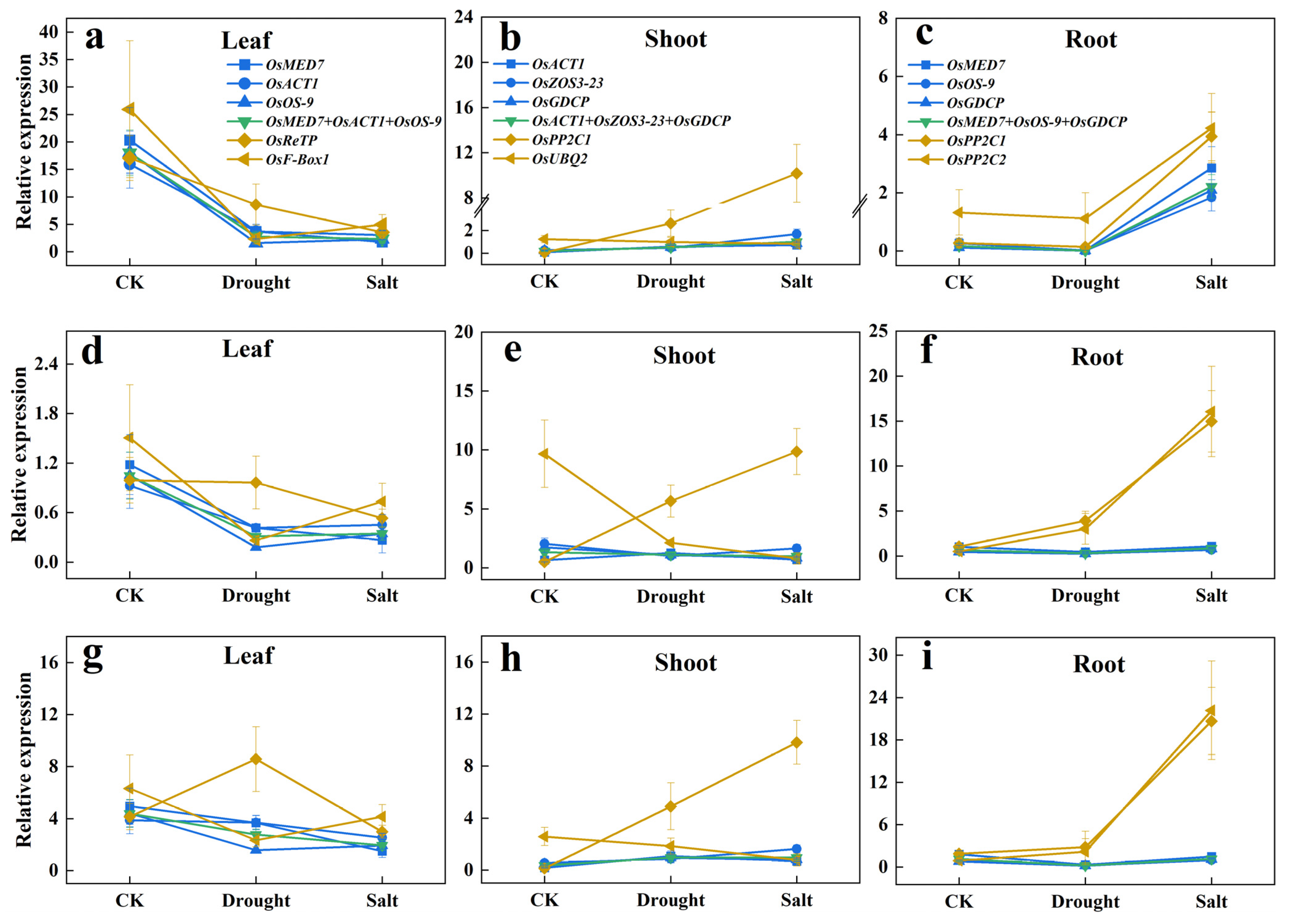Validation of Novel Reference Genes in Different Rice Plant Tissues through Mining RNA-Seq Datasets
Abstract
:1. Introduction
2. Results
2.1. Validation of Already Reported Common Reference Genes
2.2. Screening for Stably Expressed Reference Genes from RNA-Seq Datasets
2.3. Expression Profiling of the Novel Candidate Reference Genes
2.4. Expression Stability of the Novel Candidate Reference Genes Based on Five Different Statistical Algorithms
2.5. Expression Profiling of Target Genes by Using Different Novel Candidate Reference Genes
3. Discussion
4. Materials and Methods
4.1. Plant Material and Treatments
4.2. RNA Isolation and cDNA Synthesis
4.3. Selection of Candidate Reference Genes and Design of Primers
4.4. Quantitative PCR Conditions
4.5. Data Analysis
5. Conclusions
Author Contributions
Funding
Data Availability Statement
Acknowledgments
Conflicts of Interest
References
- Bustin, S.A.; Benes, V.; Nolan, T.; Pfaffl, M.W. Quantitative Real-Time RT-PCR—A Perspective. J. Mol. Endocrinol. 2005, 34, 597–601. [Google Scholar] [CrossRef] [PubMed]
- Huggett, J.; Dheda, K.; Bustin, S.; Zumla, A. Real-Time RT-PCR Normalisation; Strategies and Considerations. Genes Immun. 2005, 6, 279–284. [Google Scholar] [CrossRef] [PubMed]
- Huis, R.; Hawkins, S.; Neutelings, G. Selection of Reference Genes for Quantitative Gene Expression Normalization in Flax (Linum usitatissimum L.). BMC Plant Biol. 2010, 10, 71. [Google Scholar] [CrossRef] [PubMed]
- Zheng, M.; Wang, Y.; Wang, Y.; Wang, C.; Ren, Y.; Lv, J.; Peng, C.; Wu, T.; Liu, K.; Zhao, S.; et al. DEFORMED FLORAL ORGAN1 (DFO1) Regulates Floral Organ Identity by Epigenetically Repressing the Expression of OsMADS58 in Rice (Oryza Sativa). New Phytol. 2015, 206, 1476–1490. [Google Scholar] [CrossRef] [PubMed]
- Liu, X.; Yang, C.Y.; Miao, R.; Zhou, C.L.; Cao, P.H.; Lan, J.; Zhu, X.J.; Mou, C.L.; Huang, Y.S.; Liu, S.J.; et al. DS1/OsEMF1 Interacts with OsARF11 to Control Rice Architecture by Regulation of Brassinosteroid Signaling. Rice 2018, 11, 46. [Google Scholar] [CrossRef] [PubMed]
- Udvardi, M.K.; Czechowski, T.; Scheible, W.-R. Eleven Golden Rules of Quantitative RT-PCR. Plant Cell 2008, 20, 1736–1737. [Google Scholar] [CrossRef] [PubMed]
- Nolan, T.; Hands, R.E.; Bustin, S.A. Quantification of mRNA Using Real-Time RT-PCR. Nat. Protoc. 2006, 1, 1559–1582. [Google Scholar] [CrossRef]
- Bustin, S.A. Why the Need for qPCR Publication Guidelines?—The Case for MIQE. Methods 2010, 50, 217–226. [Google Scholar] [CrossRef]
- Jain, M.; Nijhawan, A.; Tyagi, A.K.; Khurana, J.P. Validation of Housekeeping Genes as Internal Control for Studying Gene Expression in Rice by Quantitative Real-Time PCR. Biochem. Biophys. Res. Commun. 2006, 345, 646–651. [Google Scholar] [CrossRef]
- Fang, P.; Lu, R.; Sun, F.; Lan, Y.; Shen, W.; Du, L.; Zhou, Y.; Zhou, T. Assessment of Reference Gene Stability in Rice Stripe Virus and Rice Black Streaked Dwarf Virus Infection Rice by Quantitative Real-Time PCR. Virol. J. 2015, 12, 175. [Google Scholar] [CrossRef]
- Santos, F.I.D.C.D.; Marini, N.; Santos, R.S.D.; Hoffman, B.S.F.; Alves-Ferreira, M.; De Oliveira, A.C. Selection and Testing of Reference Genes for Accurate RT-qPCR in Rice Seedlings under Iron Toxicity. PLoS ONE 2018, 13, e0193418. [Google Scholar] [CrossRef] [PubMed]
- Soni, P.; Shivhare, R.; Kaur, A.; Bansal, S.; Sonah, H.; Deshmukh, R.; Giri, J.; Lata, C.; Ram, H. Reference Gene Identification for Gene Expression Analysis in Rice under Different Metal Stress. J. Biotechnol. 2021, 332, 83–93. [Google Scholar] [CrossRef] [PubMed]
- Wang, Y.; Wan, L.; Zhang, L.; Zhang, Z.; Zhang, H.; Quan, R.; Zhou, S.; Huang, R. An Ethylene Response Factor OsWR1 Responsive to Drought Stress Transcriptionally Activates Wax Synthesis Related Genes and Increases Wax Production in Rice. Plant Mol. Biol. 2012, 78, 275–288. [Google Scholar] [CrossRef] [PubMed]
- Kumar, D.; Das, P.K.; Sarmah, B.K. Reference Gene Validation for Normalization of RT-qPCR Assay Associated with Germination and Survival of Rice under Hypoxic Condition. J. Appl. Genet. 2018, 59, 419–430. [Google Scholar] [CrossRef] [PubMed]
- Zhao, Z.; Zhang, Z.; Ding, Z.; Meng, H.; Shen, R.; Tang, H.; Liu, Y.-G.; Chen, L. Public-Transcriptome-Database-Assisted Selection and Validation of Reliable Reference Genes for qRT-PCR in Rice. Sci. China Life Sci. 2020, 63, 92–101. [Google Scholar] [CrossRef] [PubMed]
- De Andrade, L.M.; Dos Santos Brito, M.; Fávero Peixoto Junior, R.; Marchiori, P.E.R.; Nóbile, P.M.; Martins, A.P.B.; Ribeiro, R.V.; Creste, S. Reference Genes for Normalization of qPCR Assays in Sugarcane Plants under Water Deficit. Plant Methods 2017, 13, 28. [Google Scholar] [CrossRef] [PubMed]
- Song, Y.; Hanner, R.H.; Meng, B. Genome-Wide Screening of Novel RT-qPCR Reference Genes for Study of GLRaV-3 Infection in Wine Grapes and Refinement of an RNA Isolation Protocol for Grape Berries. Plant Methods 2021, 17, 110. [Google Scholar] [CrossRef]
- Czechowski, T.; Stitt, M.; Altmann, T.; Udvardi, M.K.; Scheible, W.-R. Genome-Wide Identification and Testing of Superior Reference Genes for Transcript Normalization in Arabidopsis. Plant Physiol. 2005, 139, 5–17. [Google Scholar] [CrossRef]
- Gutierrez, L.; Mauriat, M.; Gunin, S.; Pelloux, J.; Lefebvre, J.-F.; Louvet, R.; Rusterucci, C.; Moritz, T.; Guerineau, F.; Bellini, C.; et al. The Lack of a Systematic Validation of Reference Genes: A Serious Pitfall Undervalued in Reverse Transcription-Polymerase Chain Reaction (RT-PCR) Analysis in Plants. Plant Biotechnol. J. 2008, 6, 609–618. [Google Scholar] [CrossRef]
- Xu, H.; Bao, J.-D.; Dai, J.-S.; Li, Y.; Zhu, Y. Genome-Wide Identification of New Reference Genes for qRT-PCR Normalization under High Temperature Stress in Rice Endosperm. PLoS ONE 2015, 10, e0142015. [Google Scholar] [CrossRef]
- Kudo, T.; Sasaki, Y.; Terashima, S.; Matsuda-Imai, N.; Takano, T.; Saito, M.; Kanno, M.; Ozaki, S.; Suwabe, K.; Suzuki, G.; et al. Identification of Reference Genes for Quantitative Expression Analysis Using Large-Scale RNA-Seq Data of Arabidopsis Thaliana and Model Crop Plants. Genes Genet. Syst. 2016, 91, 111–125. [Google Scholar] [CrossRef] [PubMed]
- Xu, M.; Zhang, B.; Su, X.; Zhang, S.; Huang, M. Reference Gene Selection for Quantitative Real-Time Polymerase Chain Reaction in Populus. Anal. Biochem. 2011, 408, 337–339. [Google Scholar] [CrossRef] [PubMed]
- Vandesompele, J.; De Preter, K.; Pattyn, F.; Poppe, B.; Van Roy, N.; De Paepe, A.; Speleman, F. Accurate Normalization of Real-Time Quantitative RT-PCR Data by Geometric Averaging of Multiple Internal Control Genes. Genome Biol. 2002, 3, research0034. [Google Scholar] [CrossRef] [PubMed]
- Andersen, C.L.; Jensen, J.L.; Ørntoft, T.F. Normalization of Real-Time Quantitative Reverse Transcription-PCR Data: A Model-Based Variance Estimation Approach to Identify Genes Suited for Normalization, Applied to Bladder and Colon Cancer Data Sets. Cancer Res. 2004, 64, 5245–5250. [Google Scholar] [CrossRef] [PubMed]
- Pfaffl, M.W.; Tichopad, A.; Prgomet, C.; Neuvians, T.P. Determination of Stable Housekeeping Genes, Differentially Regulated Target Genes and Sample Integrity: BestKeeper—Excel-Based Tool Using Pair-Wise Correlations. Biotechnol. Lett. 2004, 26, 509–515. [Google Scholar] [CrossRef]
- Silver, N.; Best, S.; Jiang, J.; Thein, S.L. Selection of Housekeeping Genes for Gene Expression Studies in Human Reticulocytes Using Real-Time PCR. BMC Mol. Biol. 2006, 7, 33. [Google Scholar] [CrossRef]
- Xie, F.; Xiao, P.; Chen, D.; Xu, L.; Zhang, B. miRDeepFinder: A miRNA Analysis Tool for Deep Sequencing of Plant Small RNAs. Plant Mol. Biol. 2012, 80, 75–84. [Google Scholar] [CrossRef]
- Sato, Y.; Antonio, B.A.; Namiki, N.; Takehisa, H.; Minami, H.; Kamatsuki, K.; Sugimoto, K.; Shimizu, Y.; Hirochika, H.; Nagamura, Y. RiceXPro: A Platform for Monitoring Gene Expression in Japonica Rice Grown under Natural Field Conditions. Nucleic Acids Res. 2011, 39, D1141–D1148. [Google Scholar] [CrossRef]
- Liu, C.; Mao, B.; Ou, S.; Wang, W.; Liu, L.; Wu, Y.; Chu, C.; Wang, X. OsbZIP71, a bZIP Transcription Factor, Confers Salinity and Drought Tolerance in Rice. Plant Mol. Biol. 2014, 84, 19–36. [Google Scholar] [CrossRef]
- Wan, L.; Wang, X.; Li, S.; Hu, J.; Huang, W.; Zhu, Y. Overexpression of OsKTN80a, a Katanin P80 Ortholog, Caused the Repressed Cell Elongation and Stalled Cell Division Mediated by Microtubule Apparatus Defects in Primary Root in Oryza Sativa: A Katanin P80 Ortholog in Root Growth in Rice. J. Integr. Plant Biol. 2014, 56, 622–634. [Google Scholar] [CrossRef]
- Zhang, J.; Liu, Y.-X.; Zhang, N.; Hu, B.; Jin, T.; Xu, H.; Qin, Y.; Yan, P.; Zhang, X.; Guo, X.; et al. NRT1.1B Is Associated with Root Microbiota Composition and Nitrogen Use in Field-Grown Rice. Nat. Biotechnol. 2019, 37, 676–684. [Google Scholar] [CrossRef] [PubMed]
- Zhang, X.; Zhou, J.; Huang, N.; Mo, L.; Lv, M.; Gao, Y.; Chen, C.; Yin, S.; Ju, J.; Dong, G.; et al. Transcriptomic and Co-Expression Network Profiling of Shoot Apical Meristem Reveal Contrasting Response to Nitrogen Rate between Indica and Japonica Rice Subspecies. Int. J. Mol. Sci. 2019, 20, 5922. [Google Scholar] [CrossRef] [PubMed]
- Zhang, X.; Huang, N.; Mo, L.; Lv, M.; Gao, Y.; Wang, J.; Liu, C.; Yin, S.; Zhou, J.; Xiao, N.; et al. Global Transcriptome and Co-Expression Network Analysis Reveal Contrasting Response of Japonica and Indica Rice Cultivar to γ Radiation. Int. J. Mol. Sci. 2019, 20, 4358. [Google Scholar] [CrossRef] [PubMed]
- Zhou, J.; Gao, Y.; Wang, J.; Liu, C.; Wang, Z.; Lv, M.; Zhang, X.; Zhou, Y.; Dong, G.; Wang, Y.; et al. Elevated Atmospheric CO2 Concentration Triggers Redistribution of Nitrogen to Promote Tillering in Rice. Plant-Environ. Interact. 2021, 2, 125–136. [Google Scholar] [CrossRef] [PubMed]
- Ruijter, J.M.; Ramakers, C.; Hoogaars, W.M.H.; Karlen, Y.; Bakker, O.; Van Den Hoff, M.J.B.; Moorman, A.F.M. Amplification Efficiency: Linking Baseline and Bias in the Analysis of Quantitative PCR Data. Nucleic Acids Res. 2009, 37, e45. [Google Scholar] [CrossRef] [PubMed]
- Nicot, N.; Hausman, J.-F.; Hoffmann, L.; Evers, D. Housekeeping Gene Selection for Real-Time RT-PCR Normalization in Potato during Biotic and Abiotic Stress. J. Exp. Bot. 2005, 56, 2907–2914. [Google Scholar] [CrossRef] [PubMed]
- Bustin, S. Quantification of mRNA Using Real-Time Reverse Transcription PCR (RT-PCR): Trends and Problems. J. Mol. Endocrinol. 2002, 29, 23–39. [Google Scholar] [CrossRef]
- Yang, Z.; Wang, K.; Aziz, U.; Zhao, C.; Zhang, M. Evaluation of Duplicated Reference Genes for Quantitative Real-Time PCR Analysis in Genome Unknown Hexaploid Oat (Avena sativa L.). Plant Methods 2020, 16, 138. [Google Scholar] [CrossRef]
- Nguyen, D.Q.; Eamens, A.L.; Grof, C.P.L. Reference Gene Identification for Reliable Normalisation of Quantitative RT-PCR Data in Setaria Viridis. Plant Methods 2018, 14, 24. [Google Scholar] [CrossRef]
- Quan, P.-L.; Sauzade, M.; Brouzes, E. dPCR: A Technology Review. Sensors 2018, 18, 1271. [Google Scholar] [CrossRef]
- Yu, J.; Hu, S.; Wang, J.; Wong, G.K.-S.; Li, S.; Liu, B.; Deng, Y.; Dai, L.; Zhou, Y.; Zhang, X.; et al. A Draft Sequence of the Rice Genome (Oryza sativa L. Ssp. Indica). Science 2002, 296, 79–92. [Google Scholar] [CrossRef] [PubMed]
- Ouyang, S.; Zhu, W.; Hamilton, J.; Lin, H.; Campbell, M.; Childs, K.; Thibaud-Nissen, F.; Malek, R.L.; Lee, Y.; Zheng, L.; et al. The TIGR Rice Genome Annotation Resource: Improvements and New Features. Nucleic Acids Res. 2007, 35, D883–D887. [Google Scholar] [CrossRef] [PubMed]
- Wang, Z.; Gerstein, M.; Snyder, M. RNA-Seq: A Revolutionary Tool for Transcriptomics. Nat. Rev. Genet. 2009, 10, 57–63. [Google Scholar] [CrossRef] [PubMed]
- Untergasser, A.; Ruijter, J.M.; Benes, V.; van den Hoff, M.J.B. Web-Based LinRegPCR: Application for the Visualization and Analysis of (RT)-qPCR Amplification and Melting Data. BMC Bioinform. 2021, 22, 398. [Google Scholar] [CrossRef]




| Gene | Locus ID | Primer Sequence | Amplicon Product Tm (°C) | Amplicon Product Size (bp) | Efficiency (%) | R2 |
|---|---|---|---|---|---|---|
| OsACT1 | LOC_Os08g28190 | F: GTTCCCTTGTGTTGTTGGGC R: CCTCAAGTCAGCACAAGCCG | 59 | 103 | 95.8 | 0.99 |
| OsF-Box1 | LOC_Os10g26990 | F: TGTATATGATGGCAAGTG R: ATTGGATGATGGTAGGTA | 56.3 | 82 | 94.6 | 0.99 |
| OsPP2C1 | LOC_Os05g51490 | F: CATTGTTGTCCATCTTGTT R: CTCATCAGCACCTATCAG | 59 | 79 | 100.7 | 0.99 |
| OsPP2C2 | LOC_Os06g43640 | F: CAGGTTCATATCACTCAAG R: ATCATACTGGTGCTCATT | 59 | 117 | 96.3 | 0.99 |
| OsUBQ1 | LOC_Os04g48770 | F: ATTATTGAGAGGACTGTGAAGT R: TGATGGTTGCTGCGGATT | 56.3 | 78 | 106.7 | 0.98 |
| OsUBQ2 | LOC_Os04g37950 | F: ACTGCAACAGTGTCCTCCAG R: TCAAAAGGTTCTCCTCCGCA | 56.3 | 111 | 95.1 | 0.98 |
| OsGDCP | LOC_Os01g34190 | F: CGAGTTCTGCTCCTCCGTAA R: CCGTCCCGTACTTGCTACAC | 59 | 94 | 94.9 | 1.00 |
| OsHeFP | LOC_Os03g38990 | F: ACACACGATGTGGTTGCTCT R: CAAGGCGGAGAGGGCTATTT | 56.3 | 151 | 103.7 | 0.99 |
| OsMED7 | LOC_Os04g56640 | F: TTCATCTGCACCTGAACCTCC R: TCCTCTAAGCTTGGGAGCAC | 61.2 | 96 | 103.4 | 0.99 |
| OsOS-9 | LOC_Os06g43710 | F: CGGGAAAATCCGACAAGTCCA R: GCATCAGCATCATATTCACCCA | 61.2 | 78 | 97.8 | 0.99 |
| OsReTP | LOC_Os08g01070 | F: TGGGATTAAGAGAACAAGGAG R: TGCAGTCGCAGCATCTACTT | 56.3 | 133 | 105.1 | 0.99 |
| OsZOS3-23 | LOC_Os03g61640 | F: TGAATGTGTCGTTAAGATCAGC R: ACACGCATAGACATGCCCAA | 56.3 | 87 | 91.1 | 0.98 |
| OsbZIP71 | LOC_Os09g13570 | F: TGTGTGCCCTAACTGACATCCTGA R: AAGTTATGGGTGGCTGGTTCCAT | 59 | 133 | 108.0 | 0.99 |
| OskTN80b | LOC_Os04g58130 | F: TGATGCAGGGACAAAAACATGA R: CCAGGTTTTGCATCTTCCCGGGT | 59 | 120 | 93.1 | 1.00 |
| OsNRT1.1B | LOC_Os10g40600 | F: GGCAGGCTCGACTACTTCTA R: AGGCGCTTCTCCTTGTAGAC | 59 | 104 | 98.2 | 1.00 |
Disclaimer/Publisher’s Note: The statements, opinions and data contained in all publications are solely those of the individual author(s) and contributor(s) and not of MDPI and/or the editor(s). MDPI and/or the editor(s) disclaim responsibility for any injury to people or property resulting from any ideas, methods, instructions or products referred to in the content. |
© 2023 by the authors. Licensee MDPI, Basel, Switzerland. This article is an open access article distributed under the terms and conditions of the Creative Commons Attribution (CC BY) license (https://creativecommons.org/licenses/by/4.0/).
Share and Cite
Liu, X.; Gao, Y.; Zhao, X.; Zhang, X.; Ben, L.; Li, Z.; Dong, G.; Zhou, J.; Huang, J.; Yao, Y. Validation of Novel Reference Genes in Different Rice Plant Tissues through Mining RNA-Seq Datasets. Plants 2023, 12, 3946. https://doi.org/10.3390/plants12233946
Liu X, Gao Y, Zhao X, Zhang X, Ben L, Li Z, Dong G, Zhou J, Huang J, Yao Y. Validation of Novel Reference Genes in Different Rice Plant Tissues through Mining RNA-Seq Datasets. Plants. 2023; 12(23):3946. https://doi.org/10.3390/plants12233946
Chicago/Turabian StyleLiu, Xin, Yingbo Gao, Xinyi Zhao, Xiaoxiang Zhang, Linli Ben, Zongliang Li, Guichun Dong, Juan Zhou, Jianye Huang, and Youli Yao. 2023. "Validation of Novel Reference Genes in Different Rice Plant Tissues through Mining RNA-Seq Datasets" Plants 12, no. 23: 3946. https://doi.org/10.3390/plants12233946





